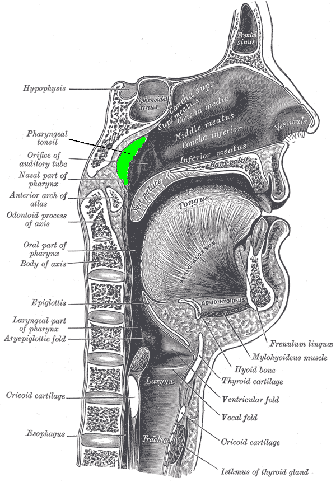The adenoid, also known as a pharyngeal tonsil or nasopharyngeal tonsil, is a mass of lymphatic tissue situated posterior to the nasal cavity, in the roof of the nasopharynx, where the nose blends into the throat. Normally, in children, it forms a soft mound in the roof and posterior wall of the nasopharynx, just above and behind the uvula.

Location of the adenoid
Structure
The adenoid, unlike the palatine tonsils, has pseudostratified epithelium The adenoid is often removed along with the palatine tonsils.
Development
Adenoids develop from a subepithelial infiltration of lymphocytes after the 16th week of embryonic life. They are part of the so-calledWaldeyer ring of lymphoid tissue which includes the palatine tonsils and the lingual tonsil.
After birth, enlargement begins and continues until aged 5 to 7 years. Symptomatic enlargement between 18 to 24 months of age is not uncommon, meaning that snoring, nasal airway obstruction and obstructed breathing may occur during sleep. However, this may be reasonably expected to decline when children reach school age, and progressive shrinkage may be expected thereafter.
The establishment of the upper respiratory tract is initiated at birth. Species of bacteria such as lactobacilli, anaerobic streptococci,actinomycosis, Fusobacterium species, and Nocardia are normally present by 6 months of age. Normal flora found in the adenoid consists of alpha-hemolytic streptococci and enterococci, Corynebacterium species, coagulase-negative staphylococci, Neisseria species, Haemophilus species, Micrococcus species, and Stomatococcus species.
Clinical significance
An enlarged adenoid, or adenoid hypertrophy, can become nearly the size of a ping pong ball and completely block airflow through the nasal passages. Even if the enlarged adenoid is not substantial enough to physically block the back of the nose, it can obstruct airflow enough so that breathing through the nose requires an uncomfortable amount of work, and inhalation occurs instead through an open mouth. The enlarged adenoid can also obstruct the nasal airway enough to affect the voice without actually stopping nasal airflow altogether.
Adenoid facies
Enlargement of the adenoid, especially in children, causes an atypical appearance of the face, often referred to as adenoid facies. Features of adenoid facies include mouth breathing, an elongated face, prominent incisors, hypoplastic maxilla, short upper lip, elevated nostrils, and a high arched palate. George Catlin, in his humorous and instructive book Breath of Life, published in 1861, illustrates adenoid facies in many engravings and advocates nose-breathing.
Removal
Surgical removal of the adenoid is a procedure called adenoidectomy. Adenoid infection may cause symptoms such as excessive mucus production, which can be treated by its removal. Studies have shown that adenoid regrowth occurs in as many as 20% of the cases after removal. Carried out through the mouth under a general anaesthetic (or less commonly a topical), adenoidectomy involves the adenoid being curetted, cauterized, lasered, or otherwise ablated.
See also Acupressure Point No. 3, 4, 11, 16 and Acupressure Point No. 20
You can see also acupressure points no 3 acupressure points no 4 acupressure points no 11 acupressure points no 16 and acupressure points no 20 for acutreatment.
All things coisndered, this is a first class post
I see you don’t monetize your site, there is one cool method to earn extra money, it will work with your page perfectly.
It is very important to have an understanding of riding techniques since
equines respond to leg pressure, how you sit in the saddle,
whether the rider is strained, as well as an entire host of various other points.
My brother recommended I might like this website.
He was once entirely right. This post actually made my day.
You can not believe simply how so much time I had spent for this info!
Thanks!
Thanks for the auspicious writeup. It in fact was once a amusement account
it. Look advanced to far brought agreeable from you! However, how
can we communicate?
My baby
Your article is very helpful for me,i like it,thanks a lot!
I think the article is very helpful for people,it has solved our problem,thanks!